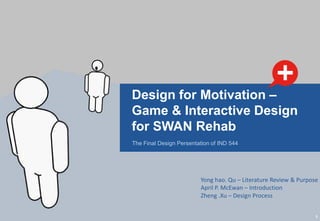
Human Factors - ASU
- 1. Design for Motivation – Game & Interactive Design for SWAN Rehab The Final Design Persentation of IND 544 Yong hao. Qu – Literature Review & Purpose April P. McEwan – Introduction Zheng .Xu – Design Process 1
- 2. Abstract With research design consisting of literature review, observations, semi-conducted interviews, visual ethnography, prototyping, testing, and qualitative data analysis methods, this research study aims at developing a mobile and adaptable game, consisting of multi-level tasks for stroke victims in rehabilitation. Two prototypes have been built and tested to find the most desired combination of tasks for stroke victims varying in levels of skill. Ideally, a finished game prototype will be both motivating and mobile. It will provide adaptable tasks for the patient and therapist, caregiver, family member, or friend that patients can use in therapy centers, at home, or anywhere. Significance The purpose of this study is to develop an understanding of stroke victims’ needs; and to construct a motivating game prototype that will assist stroke victim patients of SWAN Rehabilitation with their rehabilitation exercises. It is essential for stroke victims to exercise their affected limbs during rehabilitation if they seek recovery after stroke. Such exercises are usually repetitive and can become quite boring. Our goal has been to develop a prototype of a game that promotes healthy interaction between patients, their care givers, and therapists. 2
- 3. Purpose of Study The purpose of this study is to develop an understanding of stroke victims’ needs; and to construct a motivating game prototype that will assist stroke victim patients of SWAN Rehabilitation with their rehabilitation exercises. It is essential for stroke victims to exercise their affected limbs during rehabilitation if they seek recovery after stroke. Such exercises are usually repetitive and can become quite boring. Our goal has been to develop a prototype of a game that promotes healthy interaction between patients, their care givers, friends, family, and therapists. For the purposes of stroke rehabilitation therapy, a game that is mobile and adaptable, as well as motivating, is the objective of this research. Research Design & Methodology In order to establish an understanding of stroke victims’ needs; and to construct a motivating game prototype, we decided to design our research using observation, interview, discussion, note-taking, and visual ethnography methods. Observations and interviews were conducted at SWAN Rehab during normal hours of operation. One patient participated in the initial prototype testing. Three semi-conducted interviews and discussions were conducted with patient therapists. For purposes of this research study, one particular therapist was assigned to our research, Warren Lake. With permission from SWAN Rehab and Warren, we were able to visit SWAN Rehab during working hours in order to take photos and conduct observations, interviews, discussions, and prototype testing. 3
- 4. Research Findings During our first observation at SWAN Rehabilitation, we observed the many tasks that stroke victim patients practice during rehabilitation. Some patients practiced pronation and supination (see Figures 3 & 4) with such things as rings; and some patients practiced shoulder, arm, and finger movements by stretching and reaching for objects and placing them in slots or containers specified by the patient’s therapist. Other patients practiced walking and hip movements. 4
- 5. Brain Storming & Conceptual Framework motivation task user 5
- 6. Feedbacks We have included the tasks of pronation and supination into our prototype. As defined by Merriam-Webster’s Online Dictionary (2009), pronation is the rotation of the hand and forearm so that the palm faces backwards or downwards, and supination is the rotation of the forearm or hands so that the palm faces forward or upward… During our first observation at SWAN Rehabilitation, we observed the many tasks that stroke victim patients practice during rehabilitation. Some patients practiced pronation and supination (see Figures 3 & 4) with such things as rings; and some patients practiced shoulder, arm, and finger movements by stretching and reaching for objects and placing them in slots or containers specified by the patient’s therapist. Other patients practiced walking and hip movements 6
- 7. Prototype 1 visit Swann Rehab 7
- 8. Prototypes What did we learn from prototypes one and two? First Prototype Testing Through our initial prototype testing, we found it beneficial to offer an adaptable game that varies in levels of difficult for patients with different or adjusting levels of skill. 8
- 9. Feedbacks Most patients’ shoulders, then elbows, then hands are affected by a stroke, in that order. It is easier for a patient to move his/her shoulder than it is to move his/her fingers (therapists). 9
- 10. Design 2D drawings& 3D model by Zheng Xu AutoCAD drawings by April P. McEwan-for laser cutting of prototype 10
- 11. Scenarios The game can be folded to a box Velcro is used to connect pieces 11
- 12. Scenarios Interactive Fun 12
- 13. Step1 Step2 Step3 Step4 Step5 Step6 13
- 14. Final prototype 14
- 15. Final prototype Figure 2. Shown here in Figure 2 is the final working prototype; a proposed game for stroke victims participating in stroke rehabilitation. 15
- 16. Final prototype 16
- 17. Thank you! We would like to express our appreciation to Donald Herring, Kay Wing, Warren Lake, and the rest of South West Advanced Neurological Rehabilitation, as well as their patients, for their participation, constructive criticism, and time. Thank you for the educational experience!